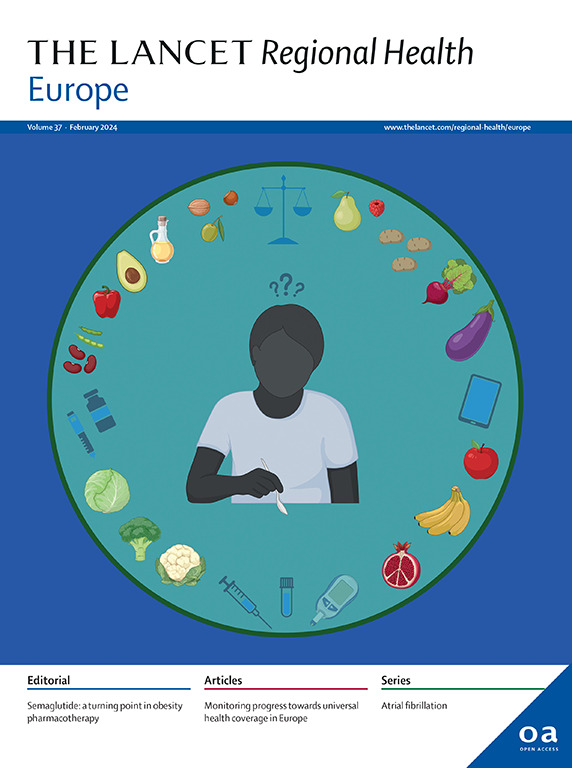Trends of non-lethal intentional self-harm and suicide in Spain 2018–2023: a nationwide registry-based study
IF 13
Q1 HEALTH CARE SCIENCES & SERVICES
引用次数: 0
Abstract
Background
Monitoring suicide and non-lethal intentional self-harm (NLISH) is critical for prevention efforts. We analysed trends in NLISH and suicide in Spain (2018–2023), including related demographic and clinical factors.
Methods
Nationwide population-based study including all NLISH hospitalisations (from health registries) and suicides (from national mortality data) in Spain between 2018 and 2023. We first examined the sociodemographic characteristics and method used for both outcomes, and the clinical characteristics of NLISH hospitalisations. Then, we evaluated annual and monthly trends in NLISH and suicide rates overall and by sex and age group using Joinpoint regression.
Findings
Between 2018 and 2023, we identified 73,692 NLISH hospitalisations and 23,496 suicides in Spain, averaging 12,282 and 3916 annually, respectively. NLISH hospitalisations were more common among women (n = 44,304; 60·1%), and suicides among men (n = 17,471; 74·4%). Youth aged 10–24 accounted for 17,915 (24·3%) NLISH hospitalisations but only 1125 (4·8%) suicides; conversely, individuals aged ≥65 represented 7327 (31·2%) suicides but only 9410 (12·8%) NLISH hospitalisations. The leading methods were drug poisoning for NLISH (n = 50,643; 68·7%) and hanging for suicide (n = 10,810; 46·0%). From 2018 to 2023, NLISH rates rose annually by 8·0% (95% CI: 1·5, 15·9), especially among young women shortly after the 2020 initial pandemic outbreak. Suicide rates rose 2·6% annually (95% CI: 0·6, 4·8), especially among young women and middle-aged men.
Interpretation
Non-lethal self-harm is rising in Spain, especially among young women. Suicide shows smaller but significant increases. Urgent, age- and gender-sensitive strategies are needed to address all suicidal behaviour and ensure timely mental health care.
Funding
ISCIII (PI23CIII/00056; CP21/00078; AC22/00006; PI22/00107; PI17/00521), EU (NextGenerationEU/MRR), ERA PerMed, FMTV3 (202220-30), AFSP (ECR-1-101-23), BBRF (NARSAD-31312), NIMH (1R25MH129256-01A1).
西班牙2018-2023年非致命性故意自残和自杀趋势:一项基于全国登记的研究
监测自杀和非致命性故意自残(NLISH)对预防工作至关重要。我们分析了西班牙NLISH和自杀的趋势(2018-2023),包括相关的人口统计学和临床因素。方法基于全国人口的研究,包括2018年至2023年间西班牙所有NLISH住院(来自卫生登记)和自杀(来自国家死亡率数据)。我们首先检查了用于两种结果的社会人口学特征和方法,以及NLISH住院治疗的临床特征。然后,我们使用Joinpoint回归评估了NLISH和总体自杀率的年度和月度趋势,并按性别和年龄组进行了评估。在2018年至2023年期间,我们在西班牙确定了73,692例NLISH住院和23,496例自杀,平均每年分别为12,282例和3916例。NLISH住院在女性中更常见(n = 44,304; 60.1%),自杀在男性中更常见(n = 17,471; 71.4%)。10-24岁的青少年有17,915人(24.3%)住院,但只有1125人(4.8%)自杀;相反,年龄≥65岁的人有7327例(31.2%)自杀,但只有9410例(12.8%)住院。以药物中毒为主(50643例,68.7%),上吊自杀为主(10810例,46.0%)。从2018年到2023年,NLISH发病率每年上升8.0% (95% CI: 1.5, 15.9),特别是在2020年首次大流行爆发后不久的年轻女性中。自杀率每年上升2.6% (95% CI: 0.6, 4.8),尤其是在年轻女性和中年男性中。在西班牙,非致命性自残正在上升,尤其是在年轻女性中。自杀率的上升幅度较小,但也很显著。需要紧急制定对年龄和性别问题敏感的战略,以处理所有自杀行为,并确保及时提供精神卫生保健。isciii (PI23CIII/00056; CP21/00078; AC22/00006; PI22/00107; PI17/00521), EU (NextGenerationEU/MRR), ERA PerMed, FMTV3 (202220-30), AFSP (ECR-1-101-23), BBRF (narad -31312), NIMH (1R25MH129256-01A1)。
本文章由计算机程序翻译,如有差异,请以英文原文为准。
求助全文
约1分钟内获得全文
求助全文
来源期刊

Lancet Regional Health-Europe
Multiple-
CiteScore
19.90
自引率
1.40%
发文量
260
审稿时长
9 weeks
期刊介绍:
The Lancet Regional Health – Europe, a gold open access journal, is part of The Lancet's global effort to promote healthcare quality and accessibility worldwide. It focuses on advancing clinical practice and health policy in the European region to enhance health outcomes. The journal publishes high-quality original research advocating changes in clinical practice and health policy. It also includes reviews, commentaries, and opinion pieces on regional health topics, such as infection and disease prevention, healthy aging, and reducing health disparities.
 求助内容:
求助内容: 应助结果提醒方式:
应助结果提醒方式:


